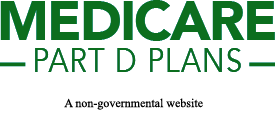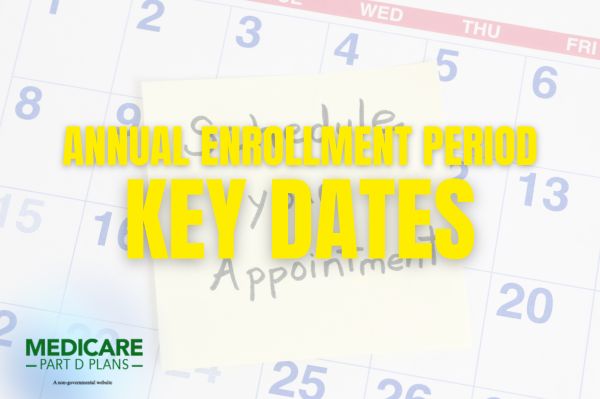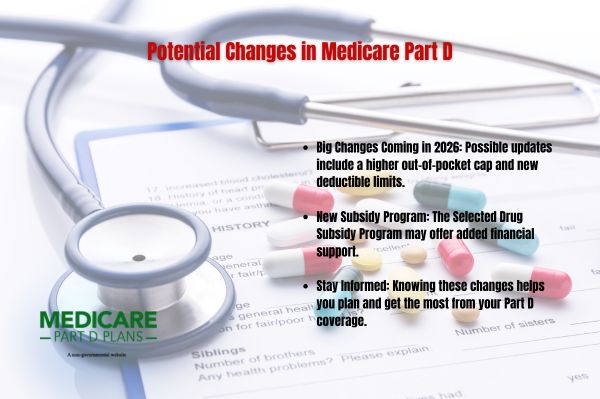Find a Medicare Part D prescription drug plan

Medicare Part D
Prescription Drug Coverage 2026
Medicare Part D Annual Enrollment Period 2026
The Medicare Part D Annual Enrollment Period
This article will guide you through the key dates, possible changes for the Medicare Part D Annual Enrollment Period
Key Takeaways
- The Medicare Part D Annual Enrollment Period (AEP)
for 2026 runs from October 15 to December 7, allowing beneficiaries to enroll or make changes to their plans to avoid late enrollment penalties.
- Potential changes
for 2026 might include an out-of-pocket cap of around $2,100, a deductible of about $615, and the possible introduction of the Selected Drug Subsidy Program which may help lower prescription costs.
- Beneficiaries should annually review and compare Medicare Part D Plans using medication lists, this website, and our licensed agents to ensure they select the most cost-effective and suitable coverage.
Key Dates for the 2026 Annual Enrollment Period
Mark your calendars! The Annual Enrollment Period (AEP) for Medicare Part D
Grasping the AEP timeline could help you avoid missing the opportunity to optimize your prescription drug coverage. Remember these dates and begin preparations early to sidestep last-minute rushes and potential pitfalls.
When Is the Annual Enrollment Period (AEP)?
The Annual Enrollment Period (AEP)
It’s highly recommended to mark these dates on your calendar. This period is essential for making changes to your Medicare Part D plan. Missing the window might result in sticking with an unsuitable plan or facing higher costs.
Deadlines and Late Enrollment Risks
Failing to enroll during the AEP may lead to:
- A late enrollment penalty, which could increase your monthly premiums for Medicare Part D.
- A lifelong addition to your premiums, meaning it may continue to affect your costs year after year.
- Coverage gaps, possibly leaving you without necessary prescription drug coverage.
Submit your enrollment request before the AEP deadline to help avoid penalties and possibly ensure continuous coverage. Proactive awareness of these deadlines could help prevent financial burdens and possibly guarantee the prescription drug coverage you need.
Potential Changes in Medicare Part D for 2026
The year
These changes will likely be designed to address the rising costs of prescription drugs and possibly provide better financial protection for Medicare beneficiaries. Being informed about these updates could help you plan your healthcare expenses more effectively and maximize the benefits of your Medicare Part D plan.
Increase in Out-of-Pocket Cap
Aware of this potential cap, you can better plan your finances, manage your healthcare budget, and potentially avoid unexpected expenses.
Updated Deductible Amount
The deductible amount for Medicare Part D
Planning for this new deductible might help manage your prescription drug expenses throughout the year. Knowing this amount in advance will likely allow for better preparation for initial costs and possibly ensure you have the necessary funds set aside.
Selected Drug Subsidy Program
Starting January 1,
This retiree drug subsidy may be equal to up to 10% of the negotiated price of selected drugs, possibly reducing the financial burden on beneficiaries and supporting Part D drug access.
This program will likely aim to make prescription medications more affordable and accessible, especially for those with high-cost prescriptions. Knowing about this potential prescription drug plan subsidy could help beneficiaries choose plans offering the best financial protection.
Comparing Medicare Part D Plans
Annually reviewing your Medicare Part D plan will likely ensure it continues to meet your needs. Comparing different plans may help you find better coverage or lower costs, which could significantly impact your healthcare expenses.
There are several methods to compare plans effectively: reviewing your medication list and costs, using this website, and calling one of our licensed agents at : 1-866-930-4039 (TTY 711) Mon-Fri: 8am-8pm EST. Each method can help you make an informed decision.
How to Compare Plans Before AEP Ends
Start by reviewing your medication list and costs from the previous year to effectively compare plans. This may help clarify your prescription needs and help identify plans that could cover your medications. Members should also compare premium rates and potential out-of-pocket costs to find a budget-friendly plan.
Check that your medications and applicable drugs may be covered under each plan’s formulary to help avoid unexpected expenses.
Using Our Website for Plan Comparison
Our website can be a valuable resource for evaluating multiple Medicare Part D plans side by side. By entering your zip code into the Plan Finder Tool, beneficiaries can analyze various plans based on coverage and cost, providing a comprehensive view of available options.
Contact one of our licensed agents for personal assistance and get recommendations based on your specific medications and healthcare needs. By filtering options based on your medication list, you can find a plan that offers the best financial protection and convenience.
Consulting Our Licensed Agents
Consulting with one of our licensed agents can provide personalized advice tailored to your health needs. Our agents can also offer valuable guidance and help navigate your Medicare options effectively.
For unbiased support during the enrollment process, consider seeking help from local licensed insurance agents or the State Health Insurance Assistance Program (SHIP). These resources can assist in finding the best insurance company health plan for your unique situation.
Understanding Cost Sharing in Medicare Part D
Cost sharing in Medicare Part D may involve multiple phases, each with different financial responsibilities for beneficiaries. Knowing these phases—deductibles, initial coverage, and catastrophic coverage—could help manage your prescription drug expenses more effectively.
- Members may incur up to 100% of their drug costs until they meet the updated deductible.
- After meeting the deductible, they transition into the initial coverage phase, where cost sharing will likely continue.
- This cost sharing may continue until out-of-pocket expenses reach a specified limit.
Initial Coverage Phase
During the initial coverage phase, beneficiaries will likely be responsible for at least 25% of their total prescription coverage drug costs. This coinsurance will likely continue until their out-of-pocket expenses reach the threshold for transitioning to the next phase.
Knowing this phase could be crucial for budgeting, as it will likely impact the amount beneficiaries need to pay before reaching catastrophic coverage.
Catastrophic Coverage Phase
Once beneficiaries reach their out-of-pocket threshold, they enter the catastrophic coverage phase. During this phase, there might not be any cost-sharing for covered Part D drugs, which could potentially reduce the financial burden for high-cost drug users.
This phase could provide crucial financial protection for those with prescription drug expenses, possibly ensuring they could access necessary medications.
See plans in your area instantly!
Advertisement
Important Considerations for Low-Income Beneficiaries
Low-income Medicare beneficiaries will likely have access to various programs designed to help reduce their out-of-pocket costs and make healthcare more affordable, including options for Medicare coverage and Medicare Advantage.
These programs might include the Extra Help program and Medicare Savings Programs, both of which could offer significant financial assistance.
Knowing these options and how to apply may impact managing healthcare expenses. These programs could be especially beneficial for those struggling to afford their medications and other healthcare costs.
Medicare Savings Programs
Medicare Savings Programs will likely be crucial for low-income beneficiaries as they could help cover costs such as premiums, deductibles, and coinsurance.
These programs could potentially reduce out-of-pocket costs for prescription drugs, making healthcare more accessible.
Accessing Medicaid services could provide much-needed financial relief and possibly ensure continued access to necessary healthcare services, such as Medicaid coverage for the applicable beneficiary.
Steps to Enroll or Make Changes During AEP
During the Annual Enrollment Period (AEP):
- The period runs from October 15 to December 7.
- It is the designated time to submit an enrollment request and make any necessary changes to your coverage.
Making changes during AEP likely ensures your coverage aligns with your healthcare needs for the upcoming year. Being proactive and informed helps avoid gaps in coverage and potential penalties.
Submitting an Enrollment Request
Enrollment requests for Medicare Part D can be submitted in several ways:
- Online through this website
- By phone by calling: 1-866-930-4039 (TTY 711) Mon-Fri: 8am-8pm EST.
These methods provide accessible options for enrolling or making changes to Part D plans. Choosing the simplified determination method that best suits your needs could simplify the enrollment process and ensure timely submission.
Find a Plan and Enroll Online Yourself!
Advertisement
Summary
As we navigate the complexities of Medicare Part D
By comparing plans, utilizing available resources, and understanding cost-sharing mechanisms, you can optimize your Medicare Part D coverage. For low-income beneficiaries, accessing programs like Extra Help and Medicare Savings Programs may provide essential financial relief. Take charge of your healthcare, stay informed, and ensure you have the coverage that best meets your needs and budget.
Frequently Asked Questions
When is the Annual Enrollment Period (AEP) for Medicare Part D in 2026 ?
The Annual Enrollment Period (AEP) for Medicare Part D
What is the potential out-of-pocket cap for Medicare Part D in 2026 ?
The out-of-pocket cap for Medicare Part D
What is the deductible amount for Medicare Part D in 2026 ?
The deductible amount for Medicare Part D
What is the Selected Drug Subsidy Program?
The Selected Drug Subsidy Program, effective January 1,
How might low-income beneficiaries reduce their out-of-pocket costs for Medicare Part D?
Low-income beneficiaries could potentially reduce some of their out-of-pocket costs for Medicare Part D by utilizing programs such as Extra Help and Medicare Savings Programs, which assist with premiums and other related expenses. Taking advantage of these resources could lead to substantial savings.
Begin Choosing your plan
Advertisement
ZRN Health & Financial Services, LLC, a Texas limited liability company.




